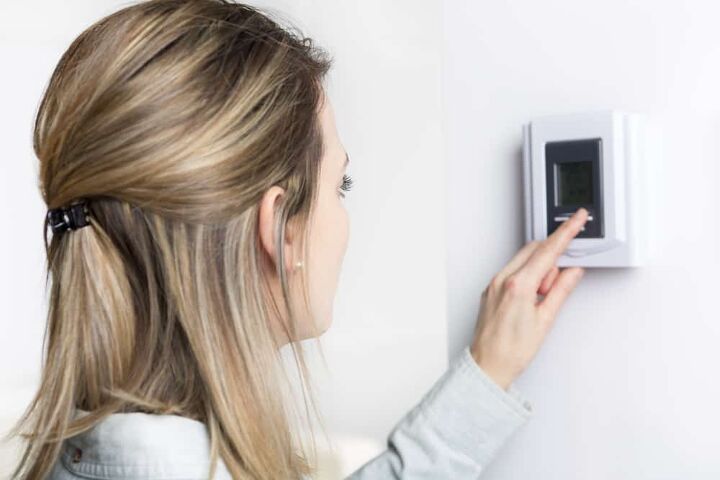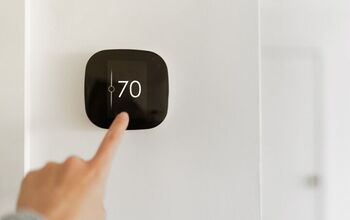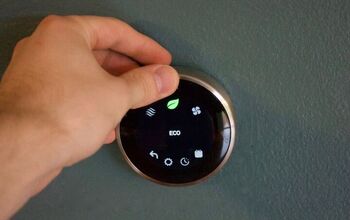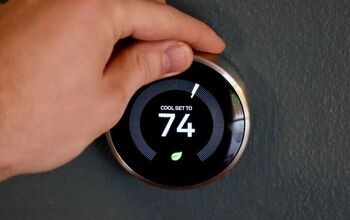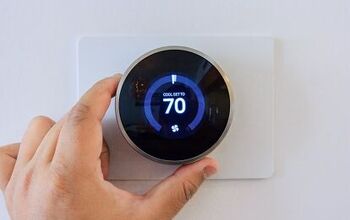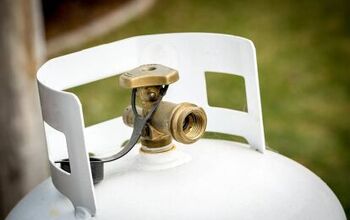No Power To The Thermostat? (Possible Causes & Fixes)

Thermostats are one of the most well-known HVAC components in any home, and that’s because they’re plainly visible and easy to use. They are meant to regulate temperature, but they can only do that if they actually have enough power to run them. So, what happens if you have a thermostat with no power? What do you do? Well, one thing you shouldn’t do is panic…
There are several common reasons why your thermostat might not be getting enough power to work. The most common reasons include:
- A Tripped Circuit Breaker
- Low Batteries
- A Dirty Thermostat
- A Bad Connection
- A Blown Thermostat Fuse
- A Bad Thermostat
- Power Outages
- Frayed Wiring Leading To The Thermostat
Not having a thermostat that’s functional is a surefire way to be uncomfortable in your home and potentially cause your heating bill to skyrocket. Thankfully, most of the fixes for this problem are relatively simple to work with, even if you’re a newbie. Let’s get started on fixing it.
Do You Need Your Thermostat Repaired or Reprogrammed?
Get free, zero-commitment quotes from pro contractors near you.

Troubleshooting A Thermostat That Doesn’t Have Power
Obviously, it can be alarming to see your thermostat suddenly go dark, but this usually isn’t the major issue that you may think it is. In order to make this endeavor easier on you, we’re going to break it down by potential causes.
A Tripped Circuit Breaker
The very first thing you should do when you notice that your thermostat has no power is to go to your circuit box and see if you’ve tripped a breaker or blown a fuse. Thermostats can be affected by blown fuses, just like any other piece of electrical equipment. If it has, switch the breaker back on and your thermostat issue should be fixed immediately.
Sometimes, you might have a breaker that connects the thermostat to your sump pump. If the original step doesn’t work, check to see if the breaker to the sump pump is tripped. If it has been tripped, switch it back on and you should see your thermostat back in action.
Note: It’s worth noting that repeated trips on a circuit breaker could mean that you’ve got too many items plugged in, or that you need to get your home rewired. If you believe this to be the case, then we strongly suggest you read up on how to rewire your home.
Low Batteries
This is yet another quick fix that anyone can do, and it’s also one of the cheapest fixes. If you’ve been noticing a “LOW BATTERY” alert flashing on your thermostat’s panel, it could be that you finally ran out of juice. To fix this, open up your thermostat, remove the batteries, and add a fresh batch in.
It’s worth noting that some thermostats do not have battery power. Older thermostats (and smart thermostats) both tend to rely on a wire hookup to get the power they need. If this is the case with yours, then you should just skip this step and check out the next potential problem.
A Dirty Thermostat
Did you know that dirt and dust can contribute to a thermostat’s ability to function? It’s true, and people don’t seem to realize how much excess dirt can impact your thermostat’s ability to function. If your thermostat has an excessive amount of dust, it can jam your thermostat’s sensors and circuitry to the point that your thermostat shuts down.
Fixing this issue is fairly easy. Just remove the thermostat from the wall, open up the casing, and use canned air to blow away the dust or brush things away with a soft-bristled brush. If there’s a serious layer of grime, grab an electronics wipe to finish cleaning off the area. Once your thermostat’s interior is cleaned out, wipe down the exterior and put it back on the wall.
Once you put it on the wall, try to turn it on. If dirt and dust was the issue, you should see it light up.
A Bad Connection
Believe it or not, it’s possible for a thermostat to have a bad connection to your HVAC unit. This is typically caused by a poor installation, or just plugging it in the wrong way. To fix this, readjust your thermostat and make sure that it is properly connected to all the circuits it needs to be connected to.
If you recently bumped into your thermostat, this might be why it no longer has power. Thankfully, this issue is starting to fall by the wayside thanks to recent improvements in thermostat design.
A Blown Thermostat Fuse
Most people don’t know this, but thermostats often have fuses that can blow when too much power courses through them. To determine if this is the case, remove the cover from your thermostat and pull out the fuse. Pull out the thing that looks like a tiny glass lightbulb or tube. (That’s the fuse!)
If the fuse has broken or loose filaments, then your thermostat just blew a fuse. All you need to do is replace the fuse, and your thermostat should be alright. If the fuse blows again, then you may have a problem with the thermostat’s circuitry, in which case, you might need a new thermostat.
A Bad Thermostat
Thermostats don’t last forever, even if they’re top of the line gear. Much like how a furnace blower motor can go bad, your thermostat can end up going bad if it’s been in use for too long. If any of the following happens to be true with your thermostat, chances are that your thermostat just died and it’s time to get a new one:
- Your thermostat hasn’t been matching the temperature that you set it to. Assuming that you have cleaned your HVAC filters and checked your heater, this is a telltale sign of a thermostat that has gone bad. In a typical setting, you should expect your thermostat to get your temperature within one degree of the temperature you set it to. If it can’t do that, it’s done.
- Lately, your thermostat has been acting up. Has your thermostat started to lower or raise the temperature by itself? Does it randomly die or have multiple fuse blows? If so, it should be fairly clear by now that you have a thermostat that needs to be replaced.
- You noticed that your temperature gauge is overheating. This could be an HVAC problem, but in most cases, it’s actually a thermostat issue. Overheating anything is a serious sign of a potential fire hazard, so switch your thermostat ASAP.
- Your thermostat is over 10 years old. Most thermostats can last for 10 years or more, but let’s be honest. If your thermostat is aging, it’s usually better to just replace it than it is to try and fix it.
Could The Problem Be Something Outside Your Thermostat?
Sometimes, the reason that your thermostat has no power won’t have anything to do with your thermostat. Heck, it might not even have anything to do with your HVAC system at all. At times, it might have more to do with the overall condition of your home. These issues might be the underlying causes, too…
Power Outages
Though this may seem like a fairly obvious statement, it’s worth noting. If your neighborhood is currently experiencing power outages, then you shouldn’t expect your thermostat to have power. Simply put, if your home doesn’t have power, you need to wait until power is restored for your thermostat to work.
If this is the case, breathe a sigh of relief and wait until the power in your neighborhood comes back on.
Malfunctioning HVAC Equipment
Sometimes, your furnace or your cooling systems may have issues that prevent the thermostat from doing its job. Usually, this will result in your furnace overheating and tripping the breaker. However, it can also lead to repeated fuses blown in your thermostat in some situations. This is particularly true when you have filters that aren’t cleaned.
If you haven’t done so already, check your furnace for issues, replace your HVAC filters, and keep an eye on the rest of your HVAC system. If you notice wild temperature fluctuations, sudden shutdowns, or anything similar, it’s a sign that your HVAC is to blame. This would be a good time to explain to your electrician or HVAC pro what is going on and ask for a professional diagnostic of your system.
Frayed Wiring Leading To The Thermostat
This is a problem that often goes hand-in-hand with a bad connection, but tends to be slightly more involved. A bad connection can just be due to your thermostat being off-kilter from a bump against a wall. When you have frayed wiring, the connection is poor or gone because the wiring in your home has frayed to the point of being unable to power your thermostat.
Wiring that leads to your thermostat can be deep within the walls, and that means the problem could be more electrical than it is something to do with your thermostat. There are several signs you can look for when dealing with this potential problem that suggest you may need to call an electrician. These include the following:
- You recently had a mouse or rat infestation. Rodents love to chew on wires. They also may move them around in a way that encourages wear and tear. This means that you might have some frayed wires as a result of your infestation. Once you have your rodent problem under control, check your house’s wiring and fix it if necessary.
- The wiring in your home is more than 15 years old. Old wiring is more prone to corrosion, which has the exact same effect as wires that have been frayed from a rat chewing on it.
- You recently had a break in your wall, construction, or similar action involving drilling into your wall. Sometimes, the wiring issue is caused by an errant drill that just pokes things the wrong way. If this is the case, you will need to fix that specific wiring rather than work with your entire electric grid.
Note: Unlike other troubleshooting steps, this is a problem that can be more difficult to detect than you’d expect. If you have run through the troubleshooter once already without success, you may want to call an HVAC professional to see if a bad connection could still be the problem.
How Bad Is A Thermostat That Doesn’t Get Power?
A thermostat that doesn’t get power is virtually useless, but the severity of the issue all depends on what’s causing the problem. If it’s something as simple as cleaning your thermostat or flipping a switch, then having a thermostat go dark is nothing to get worried about. Even if you have to replace your thermostat, that’s not too bad in the grand scheme of things.
However, there are moments where a thermostat not getting power can be a sign of something far more dangerous or troublesome. Here’s when you should get worried:
- If you have reason to believe that your thermostat’s issues are caused by faulty wiring running from your thermostat to the HVAC system, this is something that could be serious. A frayed wire in your wall might not seem like a major issue, but it’s actually a serious fire hazard. It also can be a sign of an unseen infestation, leaks inside your walls, and more. Address this with an electrician or an HVAC professional, pronto!
- Thermostats that can’t turn on after a major storm or a plumbing failure are also a signal of flooding or leaks within the walls. Water damage can easily short out wires, and this can be a cause for your thermostat to lose power that deserves to be explored. If wiring is the cause of your thermostat issues, you may want to check your home for water damage, too. This could be a reason for a call to your insurance company.
- If you’ve ruled out the thermostat as the issue and have a feeling that it could be the HVAC system, get a professional to take a look at your system. If it could be a bad furnace, there’s a chance that you could be dealing with something potentially lethal. You might need to replace your furnace before it overheats to the point of no return.
Do You Need Your Thermostat Repaired or Reprogrammed?
Get free, zero-commitment quotes from pro contractors near you.

Related Questions
Why do smart thermostats need a C-wire?
A C-wire is an electrical wire that provides a base level of electricity, even when the thermostat is shut off. Smart thermostats need to stay on as long as the house’s power is on. Otherwise, they won’t be able to properly moderate the temperature and ensure that you can change the temperature via a smartphone app.It’s important to realize that most smart thermostats use too much electricity for them to be viable via battery power. Unless you have a highly advanced smart thermostat, you will need a C-wire.
How do you clean a thermostat’s contacts?
When cleaning your thermostat’s contacts, grab a thin piece of paper and wedge it between the contacts. Wiggle the paper and then clean the grit off the paper’s edge. This should be enough to remove the dirt and grime without potentially damaging your thermostat.To ensure that your thermostat is fully cleaned, make sure to wipe down the exterior and brush the interior of your thermostat with a soft brush or canned air.
What kind of batteries does my thermostat need?
The type of batteries you should buy will change from model to model. Many thermostats work perfectly fine with AAA batteries, while older models tend to prefer AA’s. If your thermostat is particularly petite, you might need to get 3V lithium ion batteries to power your model. Some don’t use batteries at all.The best way to determine what batteries you need is to open up the thermostat or check the thermostat’s owner’s manual. The manual will give you the full details on batteries, as well as instructions on how to replace them.

Ossiana Tepfenhart is an expert writer, focusing on interior design and general home tips. Writing is her life, and it's what she does best. Her interests include art and real estate investments.
More by Ossiana Tepfenhart



